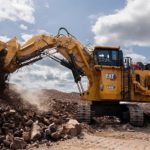Anyone who has worked underground or in surface mines knows that it’s a hard and dirty job. And the process of extracting ores and minerals usually has a negative environmental impact.

For instance, consider the haul truck. According to “Pulling the weight of heavy truck decarbonization,” a report published by the Rocky Mountain Institute, globally there are around 28,000 large mine hauling trucks in service today, almost all of them diesel-powered. The average truck burns roughly 250,000 gallons of fuel per year and emits around 2,430 tons of CO2 — equivalent to emissions from about 1,500 Prius hybrids — as well as other health-concerning pollutants like NOx and ultrafine particulates.
So to hear that mining firms and equipment manufacturers are embracing sustainability might seem to be a bit of a stretch. Nonetheless, these companies are getting serious about combating carbon emissions and upgrading their equipment and fleets. As just a few examples:
Liebherr Mining has launched the Zero Emission Program to offer low carbon emissions across its full range of trucks and excavators by 2022 and fossil fuel free hauling, digging, and dozing by 2030. Near-term solutions include haul-truck trolley assist systems and an expanded range of electric excavators. Longer-range R&D efforts focus on battery power, hybrid fuel cell-battery modules, and internal-combustion engines powered by renewable-based alternative fuels or ammonia. The company is partnering with industry experts ABB for electrification of mine sites and ENGIE for renewable hydrogen power.
Komatsu’s new Greenhouse Gas Alliance includes large mining companies like Rio Tinto, BHP, Codelco and Boliden. Alliance members are actively collaborating on product development of next-generation zero-emission mining equipment and infrastructure. The group’s initial target is advancing Komatsu’s power agnostic truck concept for haulage vehicles that can run on a variety of power sources including diesel-electric, electric, trolley (wired), battery power and even hydrogen fuel cells.
Mining giant BHP is partnering with Caterpillar to develop and deploy zero-emissions mining trucks at BHP sites and support its long-term goal of achieving net zero operational greenhouse gas emissions by 2050. Likewise, Caterpillar has agreed to develop zero-emission machines for a Nouveau Monde graphite mining project in Québec, Canada. Cat will be the exclusive supplier of an all-electric mining fleet for deployment by 2028, powered by zero carbon footprint renewable hydro-electricity.
And Volvo CE established an “emission-free” quarry as a research project. The goal was to electrify each transport stage at the site near Gothenburg, Sweden, from excavation to primary and secondary crushing. Results showed a 98% reduction in carbon emissions, 70% reduction in energy cost and a 40% reduction in operating cost.
A critical step that goes hand-in-hand with the push toward electrification is product developments that improve hydraulic efficiency. Equipment builders are demanding better performing pumps and valves, installing energy saving hydraulic regeneration circuits, and developing hydraulic management systems that electronically control and deliver the exact pressure and flow needed for each hydraulic function. The goal is to improve system efficiency, minimize losses and reduce overall power consumption. Continued R&D is essential, for example in the battle between hydrostatic drives and electric drives, especially for zero emission systems.
Mining OEMs are making substantial investments in a carbon-free future, but the moves might not be entirely altruistic, considering the crushing defeat Big Oil suffered a few months ago. Investors ousted two board members at ExxonMobil for dragging their feet on climate change efforts, and forced Chevron management to take steps to reduce its carbon footprint after a pivotal climate vote. In Europe, a Dutch court ordered Shell to take much more aggressive action to slash its carbon emissions.
Environmental groups called the results a landmark victory for climate justice, and predicted it will trigger a wave of litigation against big polluters. Equipment manufacturers and their customers have likely taken notice.






